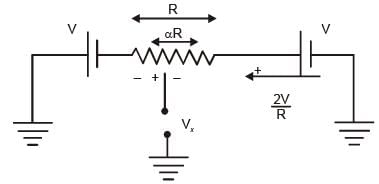All questions of Questions from Past Year Papers for Electronics and Communication Engineering (ECE) Exam
A hollow circular steel shaft (shear modulus G = 8 x 1010 N/m2) with outer and inner radii of 33 mm and 25 mm respectively, has a length of 150 mm. It is transmitting a torque of T N-m. The strain indicated by a strain gauge fixed on the outer periphery at an angle of 45° to the axis of the shaft is 5.5 microstrain (micrometer per meter). Estimate the value of T and the angular deflection of the shaft. (2002)Correct answer is '2.86'. Can you explain this answer?
A hollow circular steel shaft (shear modulus G = 8 x 1010 N/m2) with outer and inner radii of 33 mm and 25 mm respectively, has a length of 150 mm. It is transmitting a torque of T N-m. The strain indicated by a strain gauge fixed on the outer periphery at an angle of 45° to the axis of the shaft is 5.5 microstrain (micrometer per meter). Estimate the value of T and the angular deflection of the shaft. (2002)

|
Pie Academy answered |
Given: G =8 x 1010 N/m2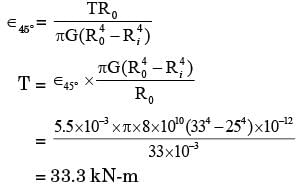

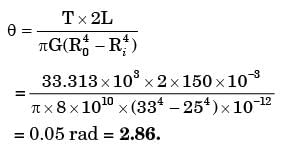
R0 = outer radius = 33 mm
Ri = inner radius = 25 mm
l = 150 mm
T = torque 0 = 45° = π/4, ε45° = strain = 5.5 x 10-3 m/m
We know that strain induced

Again from the Torsion formula,

where θ = angular deflection of the shaft

An N-type semiconductor strain gauge has a nominal resistance of 1000Ω and a gauge factor of -100. The resistance of the gage, when a compressive strain of 100 m/m is applied, is (2003)- a)900 Ω
- b)990 Ω
- c)1010 Ω
- d)1100 Ω
Correct answer is option 'B'. Can you explain this answer?
An N-type semiconductor strain gauge has a nominal resistance of 1000Ω and a gauge factor of -100. The resistance of the gage, when a compressive strain of 100 m/m is applied, is (2003)
a)
900 Ω
b)
990 Ω
c)
1010 Ω
d)
1100 Ω

|
Pioneer Academy answered |
Gauge factor,

or ΔR / R = -100 x 100 x 10-6 = -10-2 R
or ΔR = -10Ω
then, resistance of the gauge = 1000 - 10
= 990Ω.
The probability that a thermistor randomly picked up from a production unit is defective is 0.1. The probability that out of 10 thermistors randomly picked up, 3 are defective is (2015)- a)0.001
- b)0.057
- c)0.0107
- d)0.3
Correct answer is option 'B'. Can you explain this answer?
The probability that a thermistor randomly picked up from a production unit is defective is 0.1. The probability that out of 10 thermistors randomly picked up, 3 are defective is (2015)
a)
0.001
b)
0.057
c)
0.0107
d)
0.3
|
|
Bhavya Sarkar answered |
Calculation:
To calculate the probability that out of 10 thermistors randomly picked up, 3 are defective, we can use the binomial probability formula:
P(X = k) = (n choose k) * p^k * (1-p)^(n-k)
where:
- n = total number of trials (10 thermistors)
- k = number of successful trials (3 defective thermistors)
- p = probability of success (0.1, probability of a defective thermistor)
Plug in the values:
P(X = 3) = (10 choose 3) * 0.1^3 * (1-0.1)^(10-3)
P(X = 3) = (10! / (3! * (10-3)!)) * 0.001 * 0.387420489
P(X = 3) = 120 * 0.001 * 0.387420489
P(X = 3) = 0.04649
Therefore, the probability that out of 10 thermistors randomly picked up, 3 are defective is approximately 0.04649 or 0.057 (rounded to three decimal places).
To calculate the probability that out of 10 thermistors randomly picked up, 3 are defective, we can use the binomial probability formula:
P(X = k) = (n choose k) * p^k * (1-p)^(n-k)
where:
- n = total number of trials (10 thermistors)
- k = number of successful trials (3 defective thermistors)
- p = probability of success (0.1, probability of a defective thermistor)
Plug in the values:
P(X = 3) = (10 choose 3) * 0.1^3 * (1-0.1)^(10-3)
P(X = 3) = (10! / (3! * (10-3)!)) * 0.001 * 0.387420489
P(X = 3) = 120 * 0.001 * 0.387420489
P(X = 3) = 0.04649
Therefore, the probability that out of 10 thermistors randomly picked up, 3 are defective is approximately 0.04649 or 0.057 (rounded to three decimal places).
The speed of a gear having 60 teeth is measured using a proximity sensor. The output of the proximity sensor is fed to a counter with a gating time of 1s. The counter indicates a value of 120. The speed at which the gear is rotating is (2008)- a)60 rpm
- b)120 rpm
- c)600 rpm
- d)1200 rpm
Correct answer is option 'B'. Can you explain this answer?
The speed of a gear having 60 teeth is measured using a proximity sensor. The output of the proximity sensor is fed to a counter with a gating time of 1s. The counter indicates a value of 120. The speed at which the gear is rotating is (2008)
a)
60 rpm
b)
120 rpm
c)
600 rpm
d)
1200 rpm

|
Pioneer Academy answered |


Three DC currents I1, I2, and I3 meet at a node with I1 entering and I2 and I3 leaving the node. I1 and I2 are measured as 100 mA and 99 mA with a ± 1% accuracy. Then the value of I3 and the accuracy of I3 are (20020- a)1 mA ± 2%
- b)199 mA ± 2%
- c)1mA ± 2%
- d)1 mA ± 199%
Correct answer is option 'C'. Can you explain this answer?
Three DC currents I1, I2, and I3 meet at a node with I1 entering and I2 and I3 leaving the node. I1 and I2 are measured as 100 mA and 99 mA with a ± 1% accuracy. Then the value of I3 and the accuracy of I3 are (20020
a)
1 mA ± 2%
b)
199 mA ± 2%
c)
1mA ± 2%
d)
1 mA ± 199%
|
|
Zoya Sharma answered |
I3 = I1 - I2 (Using KCL at the node)
= 100 mA - 99 mA = 1 mA

The values of the material constant p for thermistors P and Q are 4000 K and 3000 K, respectively. The resistance of each thermistor at 298 K is 2 kΩ. At 373 K, the ratio of the resistance of thermistor P to that of thermistor Q will be closest to (2009)- a)1.33
- b)1.00
- c)0.75
- d)0.50
Correct answer is option 'D'. Can you explain this answer?
The values of the material constant p for thermistors P and Q are 4000 K and 3000 K, respectively. The resistance of each thermistor at 298 K is 2 kΩ. At 373 K, the ratio of the resistance of thermistor P to that of thermistor Q will be closest to (2009)
a)
1.33
b)
1.00
c)
0.75
d)
0.50
|
|
Mansi Iyer answered |
Understanding Thermistors
Thermistors are resistors whose resistance varies significantly with temperature. The relationship between resistance and temperature can be described using the material constant (p) and the resistance at a reference temperature.
Given Data
- Thermistor P:
- Material constant (p) = 4000 K
- Resistance at 298 K = 2 kΩ
- Thermistor Q:
- Material constant (p) = 3000 K
- Resistance at 298 K = 2 kΩ
Resistance Calculation at 373 K
The resistance (R) of a thermistor at temperature T can be expressed as:
R(T) = R0 * exp(p * (1/T - 1/T0))
Where:
- R0 = resistance at reference temperature T0 (298 K)
- T0 = 298 K
- T = 373 K
Now, we will calculate R_P (for thermistor P) and R_Q (for thermistor Q) at T = 373 K.
Calculating R_P
- For Thermistor P:
R_P = 2 kΩ * exp(4000 * (1/373 - 1/298))
Calculating R_Q
- For Thermistor Q:
R_Q = 2 kΩ * exp(3000 * (1/373 - 1/298))
Ratio of Resistances
To find the ratio of the resistances at 373 K:
R_P / R_Q = (R_P) / (R_Q) = (exp(4000 * (1/373 - 1/298))) / (exp(3000 * (1/373 - 1/298)))
This simplifies to:
R_P / R_Q = exp((1000) * (1/373 - 1/298))
Calculating this gives a ratio of approximately 0.50.
Conclusion
Thus, the ratio of the resistance of thermistor P to that of thermistor Q at 373 K is closest to 0.50, making the correct answer option 'D'.
Thermistors are resistors whose resistance varies significantly with temperature. The relationship between resistance and temperature can be described using the material constant (p) and the resistance at a reference temperature.
Given Data
- Thermistor P:
- Material constant (p) = 4000 K
- Resistance at 298 K = 2 kΩ
- Thermistor Q:
- Material constant (p) = 3000 K
- Resistance at 298 K = 2 kΩ
Resistance Calculation at 373 K
The resistance (R) of a thermistor at temperature T can be expressed as:
R(T) = R0 * exp(p * (1/T - 1/T0))
Where:
- R0 = resistance at reference temperature T0 (298 K)
- T0 = 298 K
- T = 373 K
Now, we will calculate R_P (for thermistor P) and R_Q (for thermistor Q) at T = 373 K.
Calculating R_P
- For Thermistor P:
R_P = 2 kΩ * exp(4000 * (1/373 - 1/298))
Calculating R_Q
- For Thermistor Q:
R_Q = 2 kΩ * exp(3000 * (1/373 - 1/298))
Ratio of Resistances
To find the ratio of the resistances at 373 K:
R_P / R_Q = (R_P) / (R_Q) = (exp(4000 * (1/373 - 1/298))) / (exp(3000 * (1/373 - 1/298)))
This simplifies to:
R_P / R_Q = exp((1000) * (1/373 - 1/298))
Calculating this gives a ratio of approximately 0.50.
Conclusion
Thus, the ratio of the resistance of thermistor P to that of thermistor Q at 373 K is closest to 0.50, making the correct answer option 'D'.
One method of measuring the radius of an arc (R) is to allow a roller of radius (r) to oscillate to and fro on the arc and measure the average time per oscillation, T seconds. The roller will then have a linear acceleration of 2g/3, where g is the acceleration due to gravity. m such an experiment, the value of the radius of the arc can be found from the expression: (2002)- a)(T2g / 6tπ2) + r
- b)(T2g / 6rπ2) - r
- c)(T2g / 6tπ2)
- d)(6r2 / T2g)
Correct answer is option 'A'. Can you explain this answer?
One method of measuring the radius of an arc (R) is to allow a roller of radius (r) to oscillate to and fro on the arc and measure the average time per oscillation, T seconds. The roller will then have a linear acceleration of 2g/3, where g is the acceleration due to gravity. m such an experiment, the value of the radius of the arc can be found from the expression: (2002)
a)
(T2g / 6tπ2) + r
b)
(T2g / 6rπ2) - r
c)
(T2g / 6tπ2)
d)
(6r2 / T2g)
|
|
Sanvi Kapoor answered |
Time period,

Where l = distance between centre of rolling to the centre of roll.
∴ 

or 

The radius of the arc, 

The expression for the capacitance (C in pF) of a parallel plate capacitor is given by: C = 6.94 x 10-3 (d2/S). The diameter (d) of each plate is 20 mm, and the spacing between the plates (S) is 0.25 mm. The displacement sensitivity of the capacitor is approximate: (2002)- a)44.4 pF/mm
- b)-44.4 pF/mm
- c)11.1 pF/mm
- d)—11.1 pF/mm
Correct answer is option 'B'. Can you explain this answer?
The expression for the capacitance (C in pF) of a parallel plate capacitor is given by: C = 6.94 x 10-3 (d2/S). The diameter (d) of each plate is 20 mm, and the spacing between the plates (S) is 0.25 mm. The displacement sensitivity of the capacitor is approximate: (2002)
a)
44.4 pF/mm
b)
-44.4 pF/mm
c)
11.1 pF/mm
d)
—11.1 pF/mm
|
|
Kabir Verma answered |

Displacement sensitivity


A differential amplifier shown below has a differential mode gain of 100 and a CMRR of 40 dB. If V1 = 0.55 V and V2 = 0.45 V, output V0 is (2008)
- a)10 V
- b)10.5 V
- c)11 V
- d)15 V
Correct answer is option 'B'. Can you explain this answer?
A differential amplifier shown below has a differential mode gain of 100 and a CMRR of 40 dB. If V1 = 0.55 V and V2 = 0.45 V, output V0 is (2008)

a)
10 V
b)
10.5 V
c)
11 V
d)
15 V

|
Constructing Careers answered |

or


or Vc = 1

= 100 (0.10) + 0.5 (1)
= 10.5 volts
In a rotameter, used for measuring flow rate of a fluid, Pa: pressure above the float, Pb: pressure below the float, A: area of float, V: volume of the float, d1: density of float material, d2: density of the fluid, g: acceleration due to gravity. The following equation describes the equilibrium of the float. (2002)- a)(Pb - Pa) A = Vg (d2 - d1)
- b)(Pa + Pb) A = Vg (d2 + d1)
- c)(Pa - Pb) A = Vg (d2 - d1)
- d)(Pb - Pa) A = Vg (d2 + d1)
Correct answer is option 'A'. Can you explain this answer?
In a rotameter, used for measuring flow rate of a fluid, Pa: pressure above the float, Pb: pressure below the float, A: area of float, V: volume of the float, d1: density of float material, d2: density of the fluid, g: acceleration due to gravity. The following equation describes the equilibrium of the float. (2002)
a)
(Pb - Pa) A = Vg (d2 - d1)
b)
(Pa + Pb) A = Vg (d2 + d1)
c)
(Pa - Pb) A = Vg (d2 - d1)
d)
(Pb - Pa) A = Vg (d2 + d1)
|
|
Zoya Sharma answered |
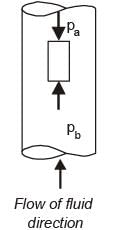
(Difference in pressure) x A = weight of float -Buoyancy force
or (Pb - Pa) A =Vg (d2 - d1)
A viscous damper consists of a sliding piston and a cylinder filled with the oil of kinematic viscosity 5 x 10-5 m2/s. A damping force of 20 N is applied on the piston and the steady-state velocity reached is 10 mm/s. The damping coefficient of the damper is (2004)- a)2 Ns/mm
- b)4 Ns/mm
- c)8 Ns/mm
- d)20 Ns/mm
Correct answer is option 'A'. Can you explain this answer?
A viscous damper consists of a sliding piston and a cylinder filled with the oil of kinematic viscosity 5 x 10-5 m2/s. A damping force of 20 N is applied on the piston and the steady-state velocity reached is 10 mm/s. The damping coefficient of the damper is (2004)
a)
2 Ns/mm
b)
4 Ns/mm
c)
8 Ns/mm
d)
20 Ns/mm
|
|
Sanya Agarwal answered |

where η = damping co-efficient
20 N = η x 10 mm/s
or η = 2 Ns/mm.
A variable capacitance angular velocity pickup is made with two concentrically mounted parallel semicircular plates with a small separation between them, as shown in Figure. A dc voltage is connected across the terminals of the capacitance sensor, as shown. For a constant angular velocity ω, the waveform of the current i(t) will be (2004)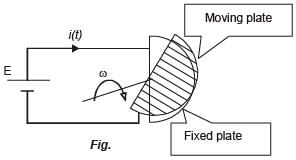
- a)dc
- b)sinusoidal
- c)triangular
- d)square
Correct answer is option 'A'. Can you explain this answer?
A variable capacitance angular velocity pickup is made with two concentrically mounted parallel semicircular plates with a small separation between them, as shown in Figure. A dc voltage is connected across the terminals of the capacitance sensor, as shown. For a constant angular velocity ω, the waveform of the current i(t) will be (2004)

a)
dc
b)
sinusoidal
c)
triangular
d)
square
|
|
Sanya Agarwal answered |
Capacitance between the plates at angle θ,
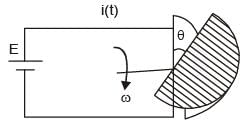





where, d = plate separation then,
qθ = CθE



i(t) = A constant for dc voltage.
A strain gauge of resistance 120Ω and gauge factor 2.0 is at zero strain condition A 200 kΩ fixed resistance is connected in parallel with it. Then the combination will represent an equivalent strain of (2004)- a)+ 5290 m/m
- b)zero
- c)- 123.8 m/m
- d)- 300 m/m
Correct answer is option 'D'. Can you explain this answer?
A strain gauge of resistance 120Ω and gauge factor 2.0 is at zero strain condition A 200 kΩ fixed resistance is connected in parallel with it. Then the combination will represent an equivalent strain of (2004)
a)
+ 5290 m/m
b)
zero
c)
- 123.8 m/m
d)
- 300 m/m
|
|
Kabir Verma answered |
Gauge factor,

or, 

or, 

[-ve sign shows compressive strain]
Fill in the blank with the correct idiom/phrase.That boy from the town was a ____ in the sleepy village. (2015)- a)dog out of the herd
- b)sheep from the heap
- c)fish out of water
- d)bird from the flock
Correct answer is option 'C'. Can you explain this answer?
Fill in the blank with the correct idiom/phrase.
That boy from the town was a ____ in the sleepy village. (2015)
a)
dog out of the herd
b)
sheep from the heap
c)
fish out of water
d)
bird from the flock
|
|
Shraddha Sarkar answered |
Understanding the Idiom "Fish Out of Water"
The phrase "fish out of water" is an idiom used to describe someone who feels uncomfortable or out of place in a particular situation. In this context, it effectively illustrates the boy's experience in the sleepy village.
Why "Fish Out of Water"?
- Contextual Meaning: The boy from the town is unfamiliar with the slow pace and lifestyle of the village. Just like a fish removed from its aquatic environment struggles to survive, he struggles to adapt to a setting that is foreign to him.
- Imagery: The imagery of a fish out of water evokes a clear picture of discomfort and dislocation. It helps readers visualize the boy's predicament and feelings of alienation.
Comparison with Other Options
- Dog Out of the Herd: This phrase does not convey the same sense of displacement. It suggests being different but lacks the specific feeling of being out of one's element.
- Sheep from the Heap: This phrase is not commonly used and does not effectively communicate the idea of feeling out of place.
- Bird from the Flock: While this phrase implies being different, it does not capture the essence of struggling in an unfamiliar environment as vividly as "fish out of water" does.
Conclusion
Choosing "fish out of water" accurately reflects the boy's struggle in the sleepy village. It encapsulates his feelings of being out of place, making it the most fitting option among the choices provided.
The phrase "fish out of water" is an idiom used to describe someone who feels uncomfortable or out of place in a particular situation. In this context, it effectively illustrates the boy's experience in the sleepy village.
Why "Fish Out of Water"?
- Contextual Meaning: The boy from the town is unfamiliar with the slow pace and lifestyle of the village. Just like a fish removed from its aquatic environment struggles to survive, he struggles to adapt to a setting that is foreign to him.
- Imagery: The imagery of a fish out of water evokes a clear picture of discomfort and dislocation. It helps readers visualize the boy's predicament and feelings of alienation.
Comparison with Other Options
- Dog Out of the Herd: This phrase does not convey the same sense of displacement. It suggests being different but lacks the specific feeling of being out of one's element.
- Sheep from the Heap: This phrase is not commonly used and does not effectively communicate the idea of feeling out of place.
- Bird from the Flock: While this phrase implies being different, it does not capture the essence of struggling in an unfamiliar environment as vividly as "fish out of water" does.
Conclusion
Choosing "fish out of water" accurately reflects the boy's struggle in the sleepy village. It encapsulates his feelings of being out of place, making it the most fitting option among the choices provided.
For a copper-constantan (Type T) thermocouple, the junction potential E (in μV) at θ°C is given by E = 38.74θ + 3.3 x 10-2θ2 + 2.07 x 10-4 θ3 - 2.2 x 10-6 θ4 + higher order terms, assuming the cold junction compensation. The sensitivity of thermocouple at 100°C is approximately (2011)- a)45.34 μV/°C
- b)42.75 μV/°C
- c)38.74 μV/°C
- d)0.06 μV/°C
Correct answer is option 'B'. Can you explain this answer?
For a copper-constantan (Type T) thermocouple, the junction potential E (in μV) at θ°C is given by E = 38.74θ + 3.3 x 10-2θ2 + 2.07 x 10-4 θ3 - 2.2 x 10-6 θ4 + higher order terms, assuming the cold junction compensation. The sensitivity of thermocouple at 100°C is approximately (2011)
a)
45.34 μV/°C
b)
42.75 μV/°C
c)
38.74 μV/°C
d)
0.06 μV/°C
|
|
Ravi Singh answered |
E = 38.74θ + 3.3 x 10-2θ2 + 2.07 x 10-4θ3 - 2.2 x 10-6 θ4
S = dE / dθ = 38.74 + 6.6 x 10-2 x 100 + 6.21 x 10-3 x (100)2 - 8.8 x 10-6 x (100)3 + ...
= [42.75 + higher order term] μV/°C.
A variable air gap type capacitor consists of two parallel plates: a fixed plate and a moving plate at a distance x. If a potential V is applied across the two plates, then the force of attraction between the plates is related to x as (2006)- a)

- b)

- c)

- d)

Correct answer is option 'B'. Can you explain this answer?
A variable air gap type capacitor consists of two parallel plates: a fixed plate and a moving plate at a distance x. If a potential V is applied across the two plates, then the force of attraction between the plates is related to x as (2006)
a)

b)

c)

d)

|
|
Sanya Agarwal answered |


If for the given system (2014) Then the natural frequency of the system is
Then the natural frequency of the system is- a)2
- b)4
- c)5
- d)6
Correct answer is option 'A'. Can you explain this answer?
If for the given system (2014)

Then the natural frequency of the system is
a)
2
b)
4
c)
5
d)
6

|
Riverdale Learning Institute answered |


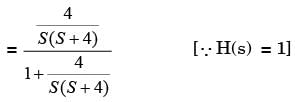


∴ Comparing S2 + 4S + 4 with original equation

∴ 

Now 

∴ ωn = 2
A single-sensor, contact-type ultrasonic flaw detector uses a frequency of 330 kHz. When testing a specimen, an echo from a flaw is recorded 0.05 mass after the transmitted pulse. If the velocity of sound in the test object is 6.0 km/s, then the flaw is at a depth of (2004)- a)120 cm
- b)60 cm
- c)30 cm
- d)15 cm
Correct answer is option 'D'. Can you explain this answer?
A single-sensor, contact-type ultrasonic flaw detector uses a frequency of 330 kHz. When testing a specimen, an echo from a flaw is recorded 0.05 mass after the transmitted pulse. If the velocity of sound in the test object is 6.0 km/s, then the flaw is at a depth of (2004)
a)
120 cm
b)
60 cm
c)
30 cm
d)
15 cm
|
|
Sanvi Kapoor answered |

= 6 km/s x 0.025 x 10-3s
= 15 cm.
Threshold of a measurement system is (2001)- a)the smallest change in input which can be detected
- b)a measure of linearity of the system
- c)the smallest input which can be detected
- d)a measure of the precision of the system.
Correct answer is option 'A'. Can you explain this answer?
Threshold of a measurement system is (2001)
a)
the smallest change in input which can be detected
b)
a measure of linearity of the system
c)
the smallest input which can be detected
d)
a measure of the precision of the system.
|
|
Sanvi Kapoor answered |
KMw

∴ 

The conventional way of expressing vibration is in terms of (2011)- a)Richter scale
- b)acceleration due to gravity
- c)speed of sound
- d)atmospheric pressure
Correct answer is option 'B'. Can you explain this answer?
The conventional way of expressing vibration is in terms of (2011)
a)
Richter scale
b)
acceleration due to gravity
c)
speed of sound
d)
atmospheric pressure
|
|
Ravi Singh answered |
The use of weighting networks gives a single number as a measure of vibration exposure and is expressed as the frequency-weighted vibration exposure in meters per second squared (m/s2) units of acceleration.
Two identical strain gauges of resistance 120Ω and gauge factor + 2.0 each are attached to a steel block of Poisson’s ratio V = 0.3 as shown in Figure. Find the unbalance voltage per unit microstrain applied to the steel block as shown. (2000)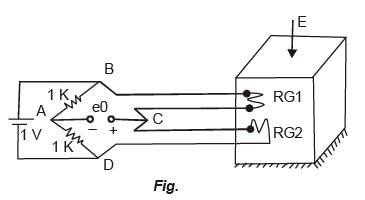 Correct answer is '2'. Can you explain this answer?
Correct answer is '2'. Can you explain this answer?
Two identical strain gauges of resistance 120Ω and gauge factor + 2.0 each are attached to a steel block of Poisson’s ratio V = 0.3 as shown in Figure. Find the unbalance voltage per unit microstrain applied to the steel block as shown. (2000)

|
|
Ravi Singh answered |
R = 120Ω V = 30 CTp = 2 e1 = 1V


ε = strain/micro stain developed
Change in O/P when strain gauge is applied

For half-bridge,

Hence for every unit microstrain applied

A piezoelectric type accelerometer has a sensitivity of 100 mV/g. The transducer is subjected to a constant acceleration of 5g. The steady-state output of the transducer will be (2008)- a)0 V
- b)100 mV
- c)0.5 V
- d)5 V
Correct answer is option 'C'. Can you explain this answer?
A piezoelectric type accelerometer has a sensitivity of 100 mV/g. The transducer is subjected to a constant acceleration of 5g. The steady-state output of the transducer will be (2008)
a)
0 V
b)
100 mV
c)
0.5 V
d)
5 V
|
|
Ravi Singh answered |
Steady state output = sensitivity x acceleration
= 100 mV/g x 5g
= 0.5 V.
A wire potentiometer of length 11 m and resistance 1 Ω/m balances a standard cell voltage of 1.018 V at a length of 10 m 18 cm. If the voltage of the battery supplying the current through the potentiometer is 2.0 V, then the value of the series resistance connected to the potentiometer is (2004)- a)9 Ω
- b)90 Ω
- c)900 Ω
- d)990 Ω
Correct answer is option 'A'. Can you explain this answer?
A wire potentiometer of length 11 m and resistance 1 Ω/m balances a standard cell voltage of 1.018 V at a length of 10 m 18 cm. If the voltage of the battery supplying the current through the potentiometer is 2.0 V, then the value of the series resistance connected to the potentiometer is (2004)
a)
9 Ω
b)
90 Ω
c)
900 Ω
d)
990 Ω
|
|
Sanya Agarwal answered |
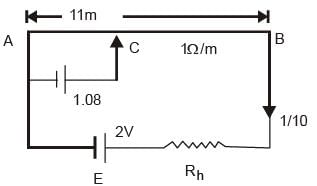


Voltage cross Rh =2 - 1.1 = 0.9 V
Then, 

The given graph is the solution of the differential equation (2014)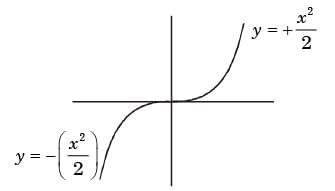
- a)

- b)

- c)

- d)

Correct answer is option 'D'. Can you explain this answer?
The given graph is the solution of the differential equation (2014)

a)

b)

c)

d)

|
|
Zoya Sharma answered |
By looking at the graph, which indicates the solution of differential equation




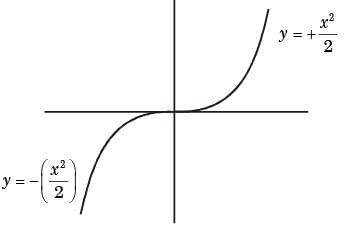
For option (d)

For > 0

∴ Now integrating both sides.


and for x > 0

Now integrating on both side.sides
Now while plotting the graph of the solution of dy differential equation dy / dx = |x|
we get

A calibrated orifice meter is used in a pipeline of 103 mm ID to calibrate the probe of a constant temperature hotwire anemometer (CTA). The orifice meter readings are recorded in mm of Hg and the CTA readings in volts. It is independently found that the average velocity in the pipeline is exactly equal to the velocity at its axis, the volume flow rate of the fluid (Q) can be measured from the orifice meter calibration equation: Q = 6.311 x 10-4√h where h is in mm of Hg and Q is in m3/s. The readings of the CTA are correlated in the form : (volt)2 = a + b (velocity)1/2. Determine the constants (a) and (b) in this equation if the voltage readings are 0.284 and 0.323 V respectively when the corresponding orifice meter readings are 77 and 154 mm Hg. (5) (2002)Correct answer is '0.09, 0.252'. Can you explain this answer?
A calibrated orifice meter is used in a pipeline of 103 mm ID to calibrate the probe of a constant temperature hotwire anemometer (CTA). The orifice meter readings are recorded in mm of Hg and the CTA readings in volts. It is independently found that the average velocity in the pipeline is exactly equal to the velocity at its axis, the volume flow rate of the fluid (Q) can be measured from the orifice meter calibration equation: Q = 6.311 x 10-4√h where h is in mm of Hg and Q is in m3/s. The readings of the CTA are correlated in the form : (volt)2 = a + b (velocity)1/2. Determine the constants (a) and (b) in this equation if the voltage readings are 0.284 and 0.323 V respectively when the corresponding orifice meter readings are 77 and 154 mm Hg. (5) (2002)
|
|
Avinash Sharma answered |
Given: Di = inner diameter = 103 mm.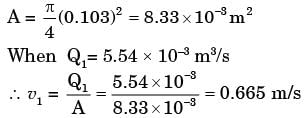
Q = 6.311 x 10-4 √h, h = mm of Hg ...(i)
(Volt)2 = a + b (Velocity)1/2...(ii)
E1 = 0.284 V
when h1 = 77 mm Hg
E2 = 0.323 V
when h2 = 154 mm Hg
From equation (i),
when h1 = 77 mm Hg,
Q1 = 6.311 x 10-4 √77 = 5.54 x 10-3 m3/s
when h2 = 154 mm Hg,
Q2 = 6.311 x 10-4 x √154 = 7.83 x 10-3 m3/s
From continuity equation, Q = A.v,
where A = Area v = velocity

The sensitivity  is (2009)
is (2009)- a)inversely proportional to R and l
- b)inversely proportional to R and directly proportional to l
- c)directly proportional to R and l
- d)directly proportional to R and inversely proportional to l
Correct answer is option 'D'. Can you explain this answer?
The sensitivity  is (2009)
is (2009)
 is (2009)
is (2009)a)
inversely proportional to R and l
b)
inversely proportional to R and directly proportional to l
c)
directly proportional to R and l
d)
directly proportional to R and inversely proportional to l

|
Pie Academy answered |
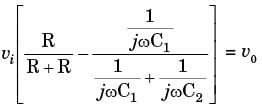
=> 

=> 

and 

=> 

A pH electrode is connected through a shielded cable to a non-inverting amplifier as shown in Figure. The resistance of the electrode is 109Ω and the leakage resistance of the shielded cable is also 109Ω. Given that the input resistance of the non-inverting amplifier is, (2000)
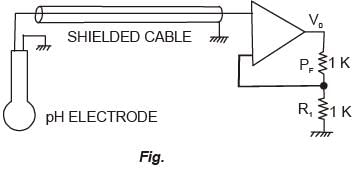 where A0 is the open-loop gain and R is the input resistance of the op-amp, find the output voltage v0 when a 100 mV signal is generated at the electrode. Assume R = 106Ω and A = 105 for i0 the op-amp used.Correct answer is '200'. Can you explain this answer?
where A0 is the open-loop gain and R is the input resistance of the op-amp, find the output voltage v0 when a 100 mV signal is generated at the electrode. Assume R = 106Ω and A = 105 for i0 the op-amp used.Correct answer is '200'. Can you explain this answer?
A pH electrode is connected through a shielded cable to a non-inverting amplifier as shown in Figure. The resistance of the electrode is 109Ω and the leakage resistance of the shielded cable is also 109Ω. Given that the input resistance of the non-inverting amplifier is, (2000)


where A0 is the open-loop gain and R is the input resistance of the op-amp, find the output voltage v0 when a 100 mV signal is generated at the electrode. Assume R = 106Ω and A = 105 for i0 the op-amp used.

|
Riverdale Learning Institute answered |
Resistance of electrode R2 = 109 Ω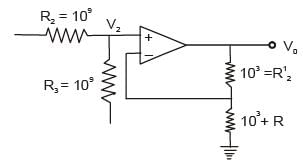
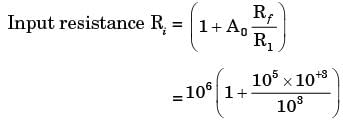
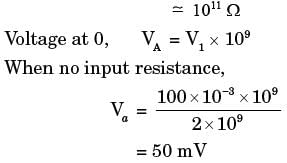
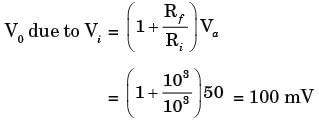
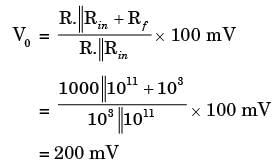
Leakage Resistance R3 = 109Ω
Ao = 105 R = 106Ω
Vi = 100 mVi




When input resistance is considered

A thermopile having a resitance of 100 Q and consisting of 20 copper-constantan thermocouples is used to measure temperature difference between two points. The temperature of the first point measured separately is 25°C. EMF generated measured by a voltage measuring device having an internal resistance of 1000 Q is 1.47 mV. E MF-temperature relationship for copper-constantan thermocouple with reference junction at 0° is as follows. (2001)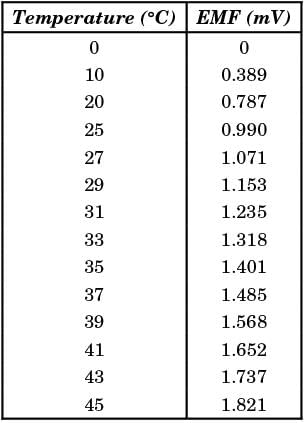 Determine the temperature difference between the two points after applying a correction for loading effect in the measurement of the EMF.Correct answer is '90.90'. Can you explain this answer?
Determine the temperature difference between the two points after applying a correction for loading effect in the measurement of the EMF.Correct answer is '90.90'. Can you explain this answer?
A thermopile having a resitance of 100 Q and consisting of 20 copper-constantan thermocouples is used to measure temperature difference between two points. The temperature of the first point measured separately is 25°C. EMF generated measured by a voltage measuring device having an internal resistance of 1000 Q is 1.47 mV. E MF-temperature relationship for copper-constantan thermocouple with reference junction at 0° is as follows. (2001)

Determine the temperature difference between the two points after applying a correction for loading effect in the measurement of the EMF.

|
Riverdale Learning Institute answered |
The thermocouple output is directly proportional to the temperature difference between hot and cold junction. Junction RJ is at a temperature of 25°C.
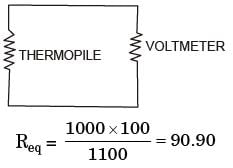

The internal resistance of voltmeter of resistance 1000Ω having a voltage of 1.47 mV

A stroboscopic system is used for measuring the speed of a rotating shaft. The shaft has one target mark on it. The maximum strobe rate at which synchronism is achieved is r1 flashes per minute. The next lower flash rate at which synchronism is achieved is r2 flashes per minute. The speed of the shaft in rpm is (2009)- a)

- b)

- c)

- d)

Correct answer is option 'A'. Can you explain this answer?
A stroboscopic system is used for measuring the speed of a rotating shaft. The shaft has one target mark on it. The maximum strobe rate at which synchronism is achieved is r1 flashes per minute. The next lower flash rate at which synchronism is achieved is r2 flashes per minute. The speed of the shaft in rpm is (2009)
a)

b)

c)

d)

|
|
Zoya Sharma answered |
Speed of the shaft,


where fm = highest flashing rate
f1 = lowest flashing rate
m = number of flashing frequency
= 2
then,

A strain gauge is attached to a bar of length 20 cm, which is subjected to a tensile force. The nominal resistance of the strain gauge is 100Ω. The changes in resistance and elongation in the bar measured are 0.35Ω and 0.2 mm, respectively. The gauge factor of the strain gauge is (2001)- a)2
- b)3.5
- c)10
- d)100
Correct answer is option 'B'. Can you explain this answer?
A strain gauge is attached to a bar of length 20 cm, which is subjected to a tensile force. The nominal resistance of the strain gauge is 100Ω. The changes in resistance and elongation in the bar measured are 0.35Ω and 0.2 mm, respectively. The gauge factor of the strain gauge is (2001)
a)
2
b)
3.5
c)
10
d)
100
|
|
Sarita Yadav answered |

The seismic mass of an accelerometer oscillates sinusoidally at 100 Hz with a maximum displacement of 10 mm from its mean position. The peak acceleration of the seismic mass is (2010)- a)3947.84 m/s2
- b)3141.50 m/s2
- c)314.15 m/s2
- d)100.00 m/s2
Correct answer is option 'A'. Can you explain this answer?
The seismic mass of an accelerometer oscillates sinusoidally at 100 Hz with a maximum displacement of 10 mm from its mean position. The peak acceleration of the seismic mass is (2010)
a)
3947.84 m/s2
b)
3141.50 m/s2
c)
314.15 m/s2
d)
100.00 m/s2
|
|
Kabir Verma answered |
Peak acceleration of seismic mass
= - xm ω2 = - 10-3 (2πf)2
= - 10-3 (2 x 3.14 x 100)2
= - 10-3 x (628)2
= 3943.84 m/s2
In the context of transducers, identify the correct matches List I with List II:List I(a) mean free path(b) humidity(c) heat transfer coefficient(d) intensity of radiationList II(p) optical pyrometer(q) Kaudsen gauge(r) sling psychrometer(s) hot wire anemometer- a)a-p, b-q, c-r, d-s
- b)a-q, b-p, c-s, d-r
- c)a-r, b-s, c-p, d-q
- d)a-q, b-r, c-s, d-p
Correct answer is option 'D'. Can you explain this answer?
In the context of transducers, identify the correct matches List I with List II:
List I
(a) mean free path
(b) humidity
(c) heat transfer coefficient
(d) intensity of radiation
List II
(p) optical pyrometer
(q) Kaudsen gauge
(r) sling psychrometer
(s) hot wire anemometer
a)
a-p, b-q, c-r, d-s
b)
a-q, b-p, c-s, d-r
c)
a-r, b-s, c-p, d-q
d)
a-q, b-r, c-s, d-p
|
|
Sarita Yadav answered |

A thermometer at room temperature 30°C is dipped suddenly into a bath of boiling water at 100°C. It takes 30 seconds to reach 96.5°C. The time required to reach a temperature of 98 °C is (2005)- a)32.5 s
- b)34.6 s
- c)35.6 s
- d)38.6 s
Correct answer is option 'B'. Can you explain this answer?
A thermometer at room temperature 30°C is dipped suddenly into a bath of boiling water at 100°C. It takes 30 seconds to reach 96.5°C. The time required to reach a temperature of 98 °C is (2005)
a)
32.5 s
b)
34.6 s
c)
35.6 s
d)
38.6 s
|
|
Sanya Agarwal answered |
Thermometer has been applied a step function at the input (i.e., the thermometer has been suddenly dipped into a bath of boiling water). So it follows an exponential relationship.
An electrical resistance strain gauge of resistance 120Ω has a gauge factor of 2. It is bonded to a steel specimen (modulus of elasticity, E = 2 * 1011 N/m2) for measuring strain. Estimate: (2002)(a) Strain induced in the specimen if tensile stress of 60 * 106 N/m2 is applied on the specimen.(b) Change in the electrical resistance of the gauge due to the tensile stress as given in (a)(c) Change in the electrical resistance of the gauge if there is an increase of temperature by 40°C.Assume the following data:Temperature coefficient of resistance of gauge is 20 * 10-6 per °CThermal coefficient of linear expansion of the gauge is 16 * 10-6 per °C.Thermal coefficient of linear expansion of steel specimen is 12 * 10-6 per °C.Correct answer is '0.3'. Can you explain this answer?
An electrical resistance strain gauge of resistance 120Ω has a gauge factor of 2. It is bonded to a steel specimen (modulus of elasticity, E = 2 * 1011 N/m2) for measuring strain. Estimate: (2002)
(a) Strain induced in the specimen if tensile stress of 60 * 106 N/m2 is applied on the specimen.
(b) Change in the electrical resistance of the gauge due to the tensile stress as given in (a)
(c) Change in the electrical resistance of the gauge if there is an increase of temperature by 40°C.
Assume the following data:
Temperature coefficient of resistance of gauge is 20 * 10-6 per °C
Thermal coefficient of linear expansion of the gauge is 16 * 10-6 per °C.
Thermal coefficient of linear expansion of steel specimen is 12 * 10-6 per °C.
|
|
Ravi Singh answered |
Given R = Resistance = 120Ω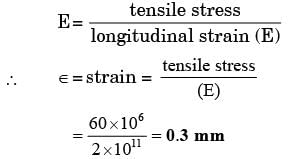


Gf = Gauge factor = 2
E = 2 x 1011 N/m2
(a) Tensile stress = 60 x 106 N/m2
We know that,


where ΔR = change in resistance
∴ ΔR = Gf x ε x R
= 2 x 0.3 x 10-3 x 120
= 0.072Ω
(c) ΔT = increase of temperature = 40°C

AR1 = change in resistance due to temperature increase
= R (1 + αg ΔT) = 120 (1 + 20 x 106 x 40) = 120.096Ω
where αg = temperature coefficient of resistance of gauge.
An RTD has a resistance of 500Ω at 20°C and a temperature co-efficient of 0.005/°C at 0°C. The RTD is used in a Wheatstone bridge circuit with R1 = R2 = 500Ω. The variable resistor R3 nulls the bridge. If the bridge supply is 10 V and the RTD is in a both of 0°C, find the values of R3 to null the bridge when (2000)(a) No self-heating of RTD is considered(b) Self-heating of RTD is considered and the dissipation constant of the RTD is 20 mW/°C.Correct answer is '454.54, 20'. Can you explain this answer?
An RTD has a resistance of 500Ω at 20°C and a temperature co-efficient of 0.005/°C at 0°C. The RTD is used in a Wheatstone bridge circuit with R1 = R2 = 500Ω. The variable resistor R3 nulls the bridge. If the bridge supply is 10 V and the RTD is in a both of 0°C, find the values of R3 to null the bridge when (2000)
(a) No self-heating of RTD is considered
(b) Self-heating of RTD is considered and the dissipation constant of the RTD is 20 mW/°C.
|
|
Kabir Verma answered |
Given α = 0.005 at 0°C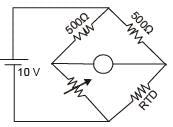
t = 20°C
Rt20 = 500Ω
Now, Rt = R0 [1 + α (T - T0)]

or 500 = 1.1 R0
or R0 = 500 / 1.1 = 454.54Ω
(a) without heating effect is 454.54Ω
(b) Dissipating constant = 20 m W/°C
A quartz crystal (Young’s modulus, E = 9 * 1010 N / m2) with piezo-electric properties has a diameter of 10 mm and thickness of 2 mm. Its voltage sensitivity constant is 4500 V/ m. If the voltage output is 127.3 V, the applied load is approximately (2002- a)100 N
- b)200 N
- c)127.3 N
- d)6.4 N
Correct answer is option 'A'. Can you explain this answer?
A quartz crystal (Young’s modulus, E = 9 * 1010 N / m2) with piezo-electric properties has a diameter of 10 mm and thickness of 2 mm. Its voltage sensitivity constant is 4500 V/ m. If the voltage output is 127.3 V, the applied load is approximately (2002
a)
100 N
b)
200 N
c)
127.3 N
d)
6.4 N
|
|
Kabir Verma answered |
E = 9 x 1010 N/m2

g = voltage sensitivity = 4500 V/m

V = voltage output = 127.3 V
We know that, 

where t = thickness
F = applied load,
A = Area

= 99.98 N ≈ 100 N
The characteristics of a thermometer measuring ambient temperature is  , where Ti and Tα are the indicated and ambient temperatures, respectively, both in °C, and time is in seconds. The -3 dB cut-off frequency in the frequency response of the thermometer is (2011)
, where Ti and Tα are the indicated and ambient temperatures, respectively, both in °C, and time is in seconds. The -3 dB cut-off frequency in the frequency response of the thermometer is (2011)- a)

- b)

- c)1 Hz
- d)2π Hz
Correct answer is option 'A'. Can you explain this answer?
The characteristics of a thermometer measuring ambient temperature is  , where Ti and Tα are the indicated and ambient temperatures, respectively, both in °C, and time is in seconds. The -3 dB cut-off frequency in the frequency response of the thermometer is (2011)
, where Ti and Tα are the indicated and ambient temperatures, respectively, both in °C, and time is in seconds. The -3 dB cut-off frequency in the frequency response of the thermometer is (2011)
 , where Ti and Tα are the indicated and ambient temperatures, respectively, both in °C, and time is in seconds. The -3 dB cut-off frequency in the frequency response of the thermometer is (2011)
, where Ti and Tα are the indicated and ambient temperatures, respectively, both in °C, and time is in seconds. The -3 dB cut-off frequency in the frequency response of the thermometer is (2011)a)

b)

c)
1 Hz
d)
2π Hz
|
|
Kabir Verma answered |

=> 

=> 

Then, ω = 0.5

During measurement of pressure by an elastic transducer, pressure is instantaneously changed in a stepwise manner from 5 bar to 30 bar. The transducer indicates a value of 20 bar after 30 secs. Assume that the transducer is a first-order instrument. (2001)(a) Determine the time constant of the transducer.(b) How much time will the transducer take to indicate the pressure within 5% of the final value?(c) On what factors does the time constant of the elastic transducer depend?Correct answer is '32.7'. Can you explain this answer?
During measurement of pressure by an elastic transducer, pressure is instantaneously changed in a stepwise manner from 5 bar to 30 bar. The transducer indicates a value of 20 bar after 30 secs. Assume that the transducer is a first-order instrument. (2001)
(a) Determine the time constant of the transducer.
(b) How much time will the transducer take to indicate the pressure within 5% of the final value?
(c) On what factors does the time constant of the elastic transducer depend?
|
|
Kabir Verma answered |

where P = pressure at any time  bar after time of 30 sec
bar after time of 30 sec
 bar after time of 30 sec
bar after time of 30 secP0 = final pressure = 30 bar
Pi = initial pressure = 5 bar

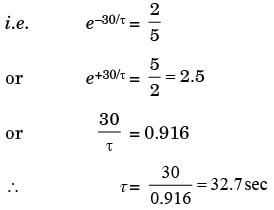
In the circuit shown below, the current through the PMMC meter is assumed to be zero.The ideal switch toggles between position 1 and position 2. For each position, it is connected for time T / 2. Assume R4 CX < t="" 2="" and="" />2 CX >> T / 2. (2006)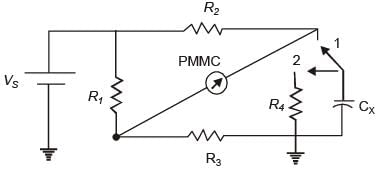 Q. The capacitor CX can be charged up to the maximum voltage
Q. The capacitor CX can be charged up to the maximum voltage- a)

- b)

- c)

- d)

Correct answer is option 'A'. Can you explain this answer?
In the circuit shown below, the current through the PMMC meter is assumed to be zero.
The ideal switch toggles between position 1 and position 2. For each position, it is connected for time T / 2. Assume R4 CX < t="" 2="" and="" />2 CX >> T / 2. (2006)

Q. The capacitor CX can be charged up to the maximum voltage
a)

b)

c)

d)

|
|
Sanya Agarwal answered |

The diameter of an aluminum sphere is found to be 50 mm at atmospheric pressure of 105 Pa. The bulk modulus for aluminum is 68.6 GPa. The change in the diameter of the sphere in microns, when placed in a vacuum is (2005)- a)0.018
- b)0.024
- c)0.032
- d)0.038
Correct answer is option 'B'. Can you explain this answer?
The diameter of an aluminum sphere is found to be 50 mm at atmospheric pressure of 105 Pa. The bulk modulus for aluminum is 68.6 GPa. The change in the diameter of the sphere in microns, when placed in a vacuum is (2005)
a)
0.018
b)
0.024
c)
0.032
d)
0.038
|
|
Sanvi Kapoor answered |
We know Bulk Modulus
= 

=> 

=> 

=> d’ - d = 0.024μm
The width of a V-groove shown in Figure is determined using a standard steel ball of diameter d and a vernier height gauge. (2001)(a) If the angle of the groove is A, derive an expression for the width w of the V-groove.(b) Given: d = 30 mm, H = 50 mm, h = 45 mm and a = 60°, calculate w.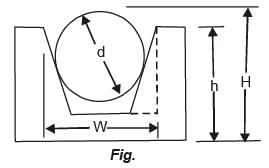 Correct answer is '55.77'. Can you explain this answer?
Correct answer is '55.77'. Can you explain this answer?
The width of a V-groove shown in Figure is determined using a standard steel ball of diameter d and a vernier height gauge. (2001)
(a) If the angle of the groove is A, derive an expression for the width w of the V-groove.
(b) Given: d = 30 mm, H = 50 mm, h = 45 mm and a = 60°, calculate w.


|
Pioneer Academy answered |
(a)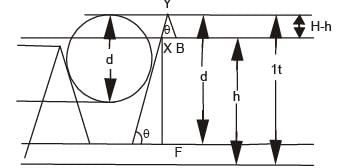


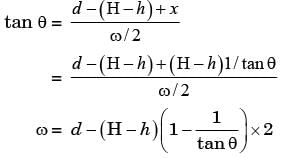
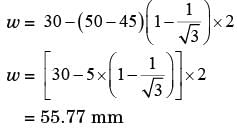

In ΔABC


In ΔCDF

(b) d = 30 mm, H = 50 mm, h = 45 mm, A = 60 = 9

The figure shows a potentiometer of total resistance RT with a sliding contact.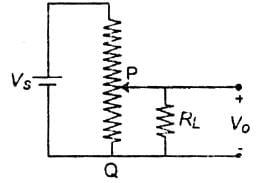 The resistance between the points P and Q of the potentiometer at the position of the contact shown is RC, and the voltage ratio VO / VS at this point is 0.5. If the ratio RL / RT = 1, the ratio RC / RT is (2007)
The resistance between the points P and Q of the potentiometer at the position of the contact shown is RC, and the voltage ratio VO / VS at this point is 0.5. If the ratio RL / RT = 1, the ratio RC / RT is (2007)- a)

- b)

- c)

- d)

Correct answer is option 'A'. Can you explain this answer?
The figure shows a potentiometer of total resistance RT with a sliding contact.

The resistance between the points P and Q of the potentiometer at the position of the contact shown is RC, and the voltage ratio VO / VS at this point is 0.5. If the ratio RL / RT = 1, the ratio RC / RT is (2007)
a)

b)

c)

d)

|
|
Sanvi Kapoor answered |


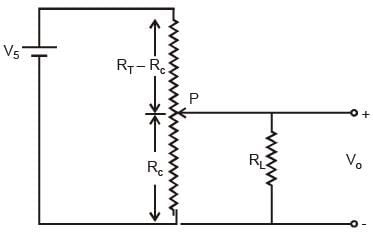

Discarding - negative value,

A thrust-producing device is tested in a laboratory by measuring the deflection of a spring element (spring constant K = 750 N/m) attached to the front end of the device. The mass of the device is 25 kg. Assuming that the thrust is idealized as step input to the system. (2002)(a) Calculate the natural frequency of the system(b) Calculate the damped natural frequency of the system, if the damping ratio is 0.7(c) Write the differential equation governing the measuring systemCorrect answer is '5.47, 3.83'. Can you explain this answer?
A thrust-producing device is tested in a laboratory by measuring the deflection of a spring element (spring constant K = 750 N/m) attached to the front end of the device. The mass of the device is 25 kg. Assuming that the thrust is idealized as step input to the system. (2002)
(a) Calculate the natural frequency of the system
(b) Calculate the damped natural frequency of the system, if the damping ratio is 0.7
(c) Write the differential equation governing the measuring system
|
|
Sanya Agarwal answered |
Given, K = 750 N/m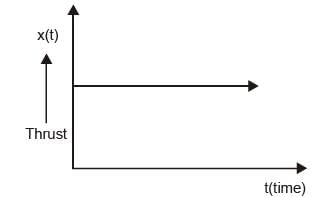




m = 25 kg
For thrust to be step input

(a) ran= Natural frequency

(b) Damping ratio = ε1 = 0.7
∴ damped natural frequency = ωd

= rad 3.83rad/s
(c) For thrust to be step input to governing differential equation of the measuring system is as follows:


where C = damping coefficient.
An LVDT is supplied with a sinusoidal voltage of amplitude 5 V and frequency 1 kHz. The output is connected to an ac voltmeter. The reading of the voltmeter is 1 V for a displacement of 1 mm from the null position. When the displacement is 1 mm in the opposite direction from the null position, the reading of the voltmeter is (2009)- a)- 1V
- b)- 0.2 V
- c)1 V
- d)5 V
Correct answer is option 'C'. Can you explain this answer?
An LVDT is supplied with a sinusoidal voltage of amplitude 5 V and frequency 1 kHz. The output is connected to an ac voltmeter. The reading of the voltmeter is 1 V for a displacement of 1 mm from the null position. When the displacement is 1 mm in the opposite direction from the null position, the reading of the voltmeter is (2009)
a)
- 1V
b)
- 0.2 V
c)
1 V
d)
5 V
|
|
Sarita Yadav answered |
At both sides of origin, voltages at the displacement of 1 mm would be the same.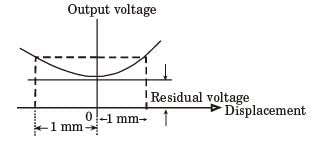

In a flyball-type angular speed magnitude measuring device, the centrifugal force, given 10-6 ω2, where ω is the angular speed in rad/s, is transmitted to spring with the non-linear characteristic F = 16π2x2, where F is the applied force and x is the spring compression in meters. The sensitivity of the device in mm.s is (2005)- a)1 / π
- b)1 / 2π
- c)1 / 3π
- d)1 / 4π
Correct answer is option 'D'. Can you explain this answer?
In a flyball-type angular speed magnitude measuring device, the centrifugal force, given 10-6 ω2, where ω is the angular speed in rad/s, is transmitted to spring with the non-linear characteristic F = 16π2x2, where F is the applied force and x is the spring compression in meters. The sensitivity of the device in mm.s is (2005)
a)
1 / π
b)
1 / 2π
c)
1 / 3π
d)
1 / 4π
|
|
Sanya Agarwal answered |
Fc = 10-6 ω2,
and Fs = 16π2x2
At equilibrium,
10-6 ω2 = 16π2x2
=> 

=> dx / dω = 1 / 4π mm.s.
In a falling-ball viscometer, the ball attains terminal velocities of 0.01 m/s for oil A and 0.002 m/s for oil B. Assuming the oils have the same density and oil A has a kinematic viscosity of 5 x 10-3 m2/s, the kinematic viscosity of oil B in m2/s is (2005)- a)15 x 10-3
- b)20 x 10-3
- c)25 x 10-3
- d)30 x 10-3
Correct answer is option ''. Can you explain this answer?
In a falling-ball viscometer, the ball attains terminal velocities of 0.01 m/s for oil A and 0.002 m/s for oil B. Assuming the oils have the same density and oil A has a kinematic viscosity of 5 x 10-3 m2/s, the kinematic viscosity of oil B in m2/s is (2005)
a)
15 x 10-3
b)
20 x 10-3
c)
25 x 10-3
d)
30 x 10-3
|
|
Sanvi Kapoor answered |
Applying Stokes formulae, we get the desired result. Here ball obtain terminal velocity because of force applied by liquid due to viscous drag, which is given by formulae F = 6 πnρv
so, kinematic viscosity = 25 × 10– 3m2/s
A certain pressure transducer measures the stagnation pressure (the total pressure). The density of the fluid is 1.03 g/cm3 and the velocity of flow is 100 cm/s. (2001)(a) Calculate the dynamic pressure (pressure due to the velocity of flow) in N/m2.(b) If the total pressure measured by the transducer is 10000 N/m2, find the static pressure in mm of Hg.Correct answer is '1.03 × 103, 74.95'. Can you explain this answer?
A certain pressure transducer measures the stagnation pressure (the total pressure). The density of the fluid is 1.03 g/cm3 and the velocity of flow is 100 cm/s. (2001)
(a) Calculate the dynamic pressure (pressure due to the velocity of flow) in N/m2.
(b) If the total pressure measured by the transducer is 10000 N/m2, find the static pressure in mm of Hg.
|
|
Sanya Agarwal answered |
Static pressure = rgh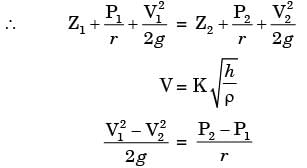

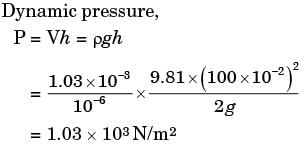



(a) Dynamic load


(b) Total pressure = pgh
or 10,000 N/m2, = 1,000 x 9.8 x h


Chapter doubts & questions for Questions from Past Year Papers - Sensor & Industrial Instrumentation 2025 is part of Electronics and Communication Engineering (ECE) exam preparation. The chapters have been prepared according to the Electronics and Communication Engineering (ECE) exam syllabus. The Chapter doubts & questions, notes, tests & MCQs are made for Electronics and Communication Engineering (ECE) 2025 Exam. Find important definitions, questions, notes, meanings, examples, exercises, MCQs and online tests here.
Chapter doubts & questions of Questions from Past Year Papers - Sensor & Industrial Instrumentation in English & Hindi are available as part of Electronics and Communication Engineering (ECE) exam.
Download more important topics, notes, lectures and mock test series for Electronics and Communication Engineering (ECE) Exam by signing up for free.
Sensor & Industrial Instrumentation
26 videos|28 docs|29 tests
|

Contact Support
Our team is online on weekdays between 10 AM - 7 PM
Typical reply within 3 hours
|
Free Exam Preparation
at your Fingertips!
Access Free Study Material - Test Series, Structured Courses, Free Videos & Study Notes and Prepare for Your Exam With Ease

 Join the 10M+ students on EduRev
Join the 10M+ students on EduRev
|

|
Create your account for free
OR
Forgot Password
OR
Signup to see your scores
go up within 7 days!
Access 1000+ FREE Docs, Videos and Tests
Takes less than 10 seconds to signup





